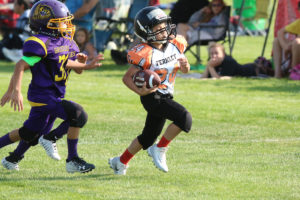Health and Safety
Concussion Prevention
American Youth Football announced they have joined with the Centers for Disease Control and Prevention (CDC) to help promote a new initiative to protect participants of all youth sports who may be at risk of concussion. The campaign entitled, “Heads Up: Concussion in Youth Sports,” expands efforts of previous CDC campaigns which were designed to protect teenagers at risk of concussion to athletes of all youth sports, regardless of age.
“We are committed to the safety of our young athletes and know that concussions are serious – and very common in youth sports,” said Joe Galat, President of American Youth Football “The tool kit developed for this campaign will get the right information about how to identify and manage a concussion directly into the hands of the people that need it the most – our youth sports coaches, parents and the athletes themselves.” A concussion is a brain injury caused by a bump or blow to the head that can change the way your brain normally works. It is estimated that as many as 3.8 million sports- and recreation-related concussions occur in the United States each year.
The new “Heads Up: Concussion in Youth Sports,” initiative includes a tool kit to help coaches, parents, and fellow athletes recognize the symptoms of a concussion and provides actions that need to be taken when an athlete is showing signs of a concussion. The tool kit is free-of-charge and includes a clipboard with essential and easy to use information about recognizing and responding to a suspected concussion.It is the campaign’s goal to equip each and every coach and parent of youth sports with the information needed to recognize and respond to concussions.
In addition to the clipboard, the new tool kit also contains:
- A fact sheet for coaches
- A fact sheet for athletes
- A fact sheet for parents
- A magnet with concussion facts for coaches and parents
- A poster with concussion facts for coaches and sports administrators; and
- A quiz for coaches, athletes, and parents.
Since youth sports administrators play a vital role in sharing educational materials with their coaches, the campaign encourages youth sports program administrators to order and distribute the tool kits to the coaches in their programs at the beginning of the sports season. Youth sport administrators and coaches are encouraged to order as many tool kits as needed and/or download extra copies of the concussion fact sheets. CDC’s aim is to get the information into the hands – and heads – of all coaches, parents and athletes. The “Heads Up” tool kit can be ordered or downloaded free-of-charge at: http://www.cdc.gov/ConcussionInYouthSports or www.americanyouthfootball.com.
Additional copies of the fact sheets for athletes and parents can be ordered at: http://www.cdc.gov/ConcussionInYouthSports.
For more information about concussions, traumatic brain injury, or injury in general, visit americanyouthfootball.com or the CDCInjuryCenter’s website at www.cdc.gov/injury.
Helmet to Helmet
Like the NFL, the NFHS is being proactive to protect their product. SYFL has a vested interest to get this portion of the game right also. This link has all of the Aloha videos from 2007 to 2012. The first on the page is the 2012 helmet contact video. Head to head contact is a major emphasis at all levels and officials will be watching it closely. There may be ejections if it is intentional. The video shows various helmet to helmet hits and the commentator makes reccomendations for ejections.
Heat Illness
Cleveland Clinic Tips to Prevent Heat Illness
A heat related illness occurs when the body is not able to regulate, or control, its temperature.
If left untreated, a heat illness can lead to serious complications, even death. If detected and treated early, however, most serious problems can be avoided.
1. Proper Hydration
- Pre- and post-exercise hydration
- Drink water and electrolyte drinks
- Limit excessive caffeine consumption
2. Be Aware of Supplements
- Research has shown supplements use can raise blood pressure, speed heart rate and contribute to dehydration.
- Products containing ephedrine contribute to fatal heart rhythm difficulties, heat related illnesses, stroke, and seizures.
- Ephedrine raises the body’s heat production and body temperatures and increases the risk of developing heat illnesses.
- Supplements are not regulated by the Food and Drug Administration (FDA). As a result, nutritional labels may be inconsistent.
- Creatine may be linked to muscle cramping if working out in the heat of the day.Creatine may be linked to muscle cramping if working out in the heat of the day.
3. Keep Cool
- Use ice towels
- Use cold tub
- Wear light-weight, light-colored clothing
4. High Risk Athletes
- Overweight & unfit athletes have a tendency to overheat.
5. Stay Healthy
- Eat a well-balanced diet
- Salt food lightly, if not hypertensive
- Monitor weight before and after each practice session
- Monitor urine: Clear or light yellow for color of unrine
- Get plenty of rest
6. Notify Medical Professional if experiencing any signs of dehydration and heat illness
For more information:
Learn how to recognize heat-related illness
Cleveland Clinic’s Sports Health
USA FOOTBALL Heads Up Certifications
Reno Huskies
Hug Hawks
McQueen Lancers
North Valleys Panthers
Reed Raiders
Damonte Ranch
Spanish Spring Cougars
Wooster Colts
Lassen
Fallon Greenwave
Fernley

